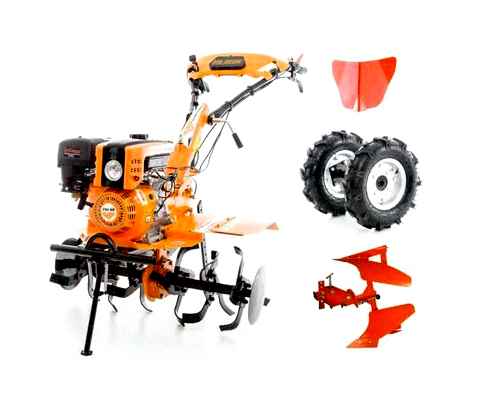Rear drive for the mole motocultivator with their own hands
Design of motocultivator Krot MK-9-01
If there is no reverse on your mole cultivator, it can be made with a special set.
Pulley leading double on the engine with a landing on the shaft 19 or 20 mm.
Double pulley on a power tiller reducer.
Bracket with reverse idler.

WARNING. Delivery is made to the order amount from 3000 p.
Mole mowing machines produced by the Moscow IGO named after V.I. Lenin. В.В. Chernyshova, are widely used among gardeners, who usually buy them in a set with rotors, which is enough for processing the soil on the individual plots.
For rice. 7.a shows the left side rotor part of the power tiller. On the example of this part let’s analyze some disadvantages of Mole‘s construction, to be exact, the disadvantages of its rotors. first of all the blades of the rotors are very blunt and the pins that fix the inner rotor to the gearbox shaft and the outer rotor to the inner rotor are too far out of the rotor shafts.
As a result, roots and plant stems get wound up on the protruding parts of the pins, which together with the soil clog the space between the inner rotor and the gear housing, as well as between the two rotors. All this puts extra load on the gearbox shaft and the rotors start to rotate unevenly.
The spring retainers, which are inserted into the holes in the pins, are also too long, which maximizes the possibility of roots and plants winding up on them with the above-mentioned consequences! Again, the bolts that fasten the blades to the square flanges of the corresponding rotors are longer than necessary.
I got rid of the first drawback. blunt blades. right after buying the “Mole“, by sharpening them with an emery until they were fixed on the flanges. The other drawbacks I have revealed after the first spring tillage in 1994, and of course, eliminated them, which greatly facilitated the further exploitation of the “Mole.
Now a little more about the correction of other deficiencies. In Fig. 8, a and b show the diameters of the rotor tubes and the lengths of the pins inserted in the holes of these tubes. One can see that pin 1 projects from the corresponding pipe by 9 mm, and pin 2. by 11 mm. To “sink” heads of pins, has made in pipes of rotors from one side of a groove in diameter of 15,6 mm and depth of 2 mm, and the cylindrical parts of pins has reduced to length 44 and 36 mm accordingly, having drilled in them on distance 2,5 mm from end faces through holes in diameter 2 mm.
Instead of the old long clamps made of 2.5 mm diameter wire, I made rings (like key rings) out of springy 1.5 mm diameter wire. The ring is inserted by one end in a hole of a pin (fig. 8, c), fixing it on the tube. In 3 years of operation, there have been no cases of losing rings during tillage, and the accumulation of roots and soil has practically stopped.
Bolts 7 (see Fig. Figs. 7) I shortened them by 5mm and screwed 5mm nuts on them (2mm thinner than they were).
All blades in the place of fixing to the flanges I have cut off on 6 mm, as it is shown on fig. 9, a and b, so that these edges were flush with the edges of the flanges. Then I sharpened the edges of the knives, shaded by crossed lines, at an angle of 45° (if when sharpening the knife we remove metal from one side of it, when forming a chamfer. from the other side).
Left side rotor flanges (Fig. 9, b and c) I also ground the edges at a 45° angle on four sides for a length of 72 mm. of the rotor flanges on the right side of the gearbox shaft I ground the edges on the same sides, but I shifted the sharpening to the opposite edge of the rib (Fig. 9, d the places of such sharpening are opposite to the bold lines).
Мотокультиватор Крот.Motor-cultivator Mole
Such modification of knives and flanges eliminated grooves, reduced the accumulation of soil in them and on the flat faces of flanges and knives, made it easier to use this mole cultivator.
Mole Cultivators. Maintenance. Possible malfunctions, repair. Preparation of the cultivator for storage
Probably no brand of garden equipment in the history of not been exposed to such modernization and improvement as motokultivator Mole. And all in many respects due to the unique design of the running gear. Due to the possibility of affordable reinstallation of the engine, both unit owners and developers have created a huge number of variations of mole cultivators.